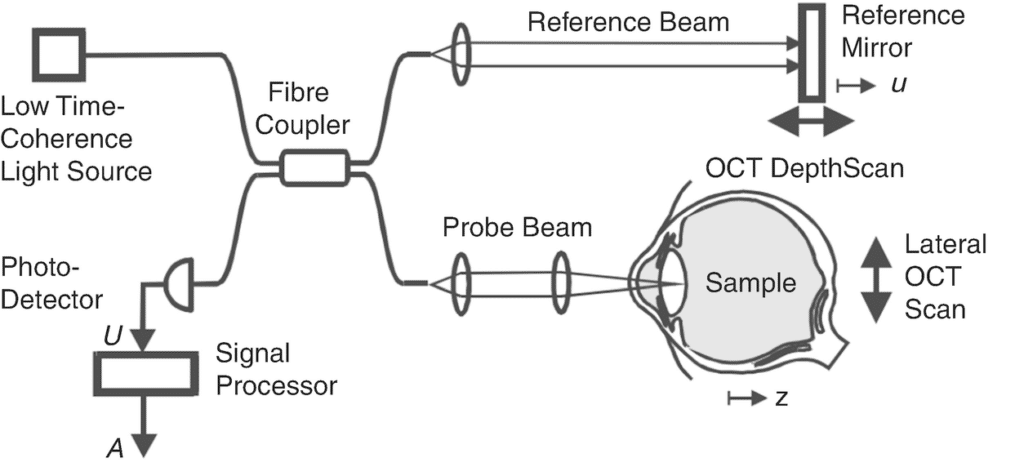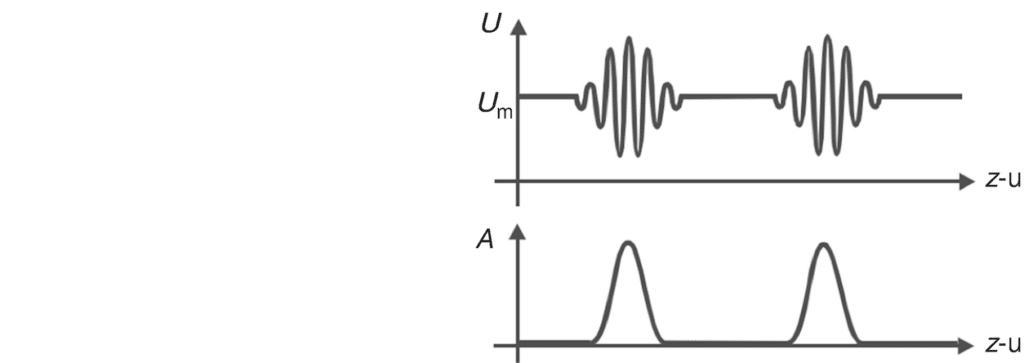Optical Coherence Tomography (OCT) is a groundbreaking imaging technology widely used in ophthalmology to obtain high-resolution, cross-sectional images of the retina and other ocular structures. This non-invasive technique utilizes light waves to capture detailed images, much like an ultrasound uses sound waves, but with much higher resolution.
OCT has revolutionized the diagnosis and management of eye conditions, enabling early detection of diseases such as glaucoma, diabetic retinopathy, and age-related macular degeneration (AMD). By providing detailed images of the retina’s layers, OCT allows for precise monitoring of disease progression and the effectiveness of treatments.
How OCT Eye Scan Works?
OCT operates by directing a beam of light into the eye, which then reflects off various layers of the retina. The reflected light is captured and processed to create a detailed, layered image of the retina’s structure. This allows for the identification of subtle abnormalities that may not be visible through other imaging techniques.


How TD-OCT works: The light from the light source is split into a reference beam and a central beam. The reflected light from both arms is combined again and recorded by a detector. To record a depth profile (A-scan) of the sample, the reference arm must be scanned. This must be repeated for each lateral scan position.(1)
Why are Galvanometers Important for OCT Eye Scan?
A critical component in the functionality of OCT systems is the galvanometer. This device is responsible for the precise steering of the light beam across the retina. The accuracy and speed of the galvanometer directly affect the quality and resolution of the images produced. High-performance galvanometers ensure that the light scans across the eye in a controlled and accurate manner, leading to the detailed imaging required for effective diagnosis and treatment.
Development Prospects of the OCT Eye Scan Industry
The global OCT market size is valued to be USD 1.44 billion in 2023. It is expected to grow from USD 1.54 billion in 2024 to USD 2.73 billion in 2032, at a compound annual growth rate (CAGR) of 7.43% during the 2024-2032. (2)(Source: market research future) The OCT eye scanning industry is poised for significant growth in the coming years, driven by technological advancements and increasing demand for non-invasive diagnostic tools. The global OCT market, particularly in ophthalmology, is expected to expand as more healthcare providers adopt this technology for routine eye examinations and specialized care.
Recent advancements in OCT technology have focused on increasing scanning speed and image resolution, both of which are heavily dependent on the performance of laser galvanometers. Innovations in AI and machine learning are also being integrated into OCT systems, offering the potential for automated image analysis and enhanced diagnostic capabilities. These developments are expected to further accelerate the adoption of OCT technology in ophthalmology and beyond.
As the OCT market continues to grow, the demand for high-performance laser galvanometers that can meet the evolving needs of the industry will also increase. Manufacturers are likely to focus on developing galvanometers that offer higher speed, greater precision, and improved stability to keep pace with these advancements.
Conclusion
Laser galvanometers are a cornerstone of OCT eye scanning systems, playing a critical role in the precision and speed of imaging. As the OCT industry continues to evolve, the importance of high-performance galvanometers will only grow, making them an essential component for any healthcare provider looking to deliver the best possible care.
When choosing a galvanometer for OCT eye scanning, it’s important to consider factors such as speed, precision, stability, compatibility, and durability to ensure optimal performance. By investing in the right galvanometer, you can ensure that your OCT system delivers high-quality images that are crucial for accurate diagnosis and treatment planning.
The future of OCT eye scanning is bright, with continued advancements in technology and expanding applications in various areas of medicine. As these developments unfold, laser galvanometers will remain at the forefront of this exciting industry, driving innovation and improving the quality of care for patients around the world.
If you need to know or buy a galvanometer, please contact us.
REFERENCES
(1) https://link.springer.com/chapter/10.1007/978-3-030-16638-0_3
(2) https://www.marketresearchfuture.com/reports/optical-coherence-tomography-market-1328
